Initially this guide displays common species likely to be flitting right now. Use the selectors below to view by color, include rare species, or search by name.
Over 100 species of butterflies and skippers have been identified in the Los Alamos area, and over 150 in the Jemez Mountains. This guide mainly includes the common species, but even some of these are difficult to tell apart. For example, we have 4 species of fritillaries with very subtle differences.
In addition, there are an equally large number of moths in the area. However, most moths are active at night they are not as readily observed. Therefore, this guide primarily focuses on the moths that are more obvious due to their size or the fact that they are active during the day. The easiest way to tell a moth from a butterfly is to look at the antennae. The moth has feathery or saw-edged antennae, while the butterfly has antennae that look like a long shaft with a bulb at the end. In addition, moths and butterflies tend to hold their wings differently. Moths tend to fold their wings down to form a tent over their abdomen, hiding it from view. In contrast, butterflies usually hold their wings vertically up over their backs.
Both butterflies and moths develop through a process of complete metamorphosis with four stages: egg, larva, pupa, and adult. The young are very different from the adults and often eat different types of food. Pictures of the caterpillar larva for many of the species in this guide are included.
Get current information by joining PEEC Butterfly Watchers and taking a look at PEEC’s Butterfly, Skipper, and Moth set on Flickr. Additional information can be found in Butterflies through Binoculars: The West and Kaufman Field Guide to Butterflies of North America. Close-focusing binoculars are the best equipment for watching adult butterflies and moths.
Butterfly and Moth References
BugGuide
Butterflies and Moths of North America
Cary, S., 2009 Butterfly Landscapes of New Mexico. New Mexico Magazine
eNature
Glassberg, J., 2001 Butterflies Through Binoculars: The West. Oxford University Press
How to Build a Butterfly Garden
Subject Area Experts (all guides)
Steve Cary (butterflies)
Beth Cortright (insects)
Terry Foxx (invasive plants)
Leslie Hansen (mammals)
Richard Hansen (fish, mammals)
Dorothy Hoard (butterflies, trees)
Chick Keller (flowers, herbarium)
Shari Kelley (geology)
Kirt Kempter (geology)
Garth Tietjen (reptiles)
David Yeamans (birds)
Web Development and Content Management
Pat Bacha
Jennifer Macke
Graham Mark
Akkana Peck
Contact
Please contact us for local nature questions and sightings. We welcome comments, corrections, and additions to our guides.
For more information about local nature, please visit our Nature Blog or subscribe to PEEC This Week.
Make Selection
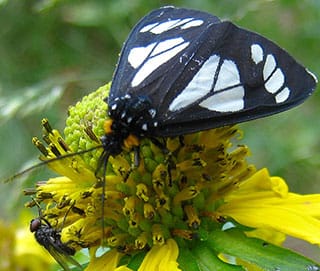 Photo: Marion Stelts 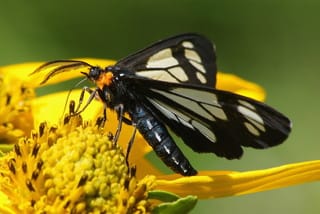 Photo: J. N. Stuart 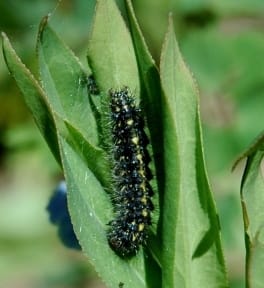 Photo: William M. Ciesla | Police Car Moth, Green Lattice Moth(Gnophaela vermiculata)Family: Arctiinae subfamily (Tiger and Lichen Moths) Size: 1.9 - 2.1 in (5 - 5 cm) Color: black Flits: Jun 01 - Sep 15 Status: native; uncommon Food source: nectar from plants such as thistle and goldenrod Host: bluebells, puccoon and stickweed Habitat: widely distributed at mid-elevation Police Car Moths have wings with very distinctive white patches with black veins. They are diurnal and fly fairly slowly between flower so that they are easy to net. Info Photos |
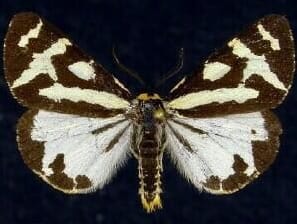 Photo: Jim Vargo 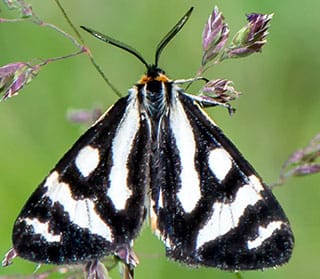 Photo: Andrew White 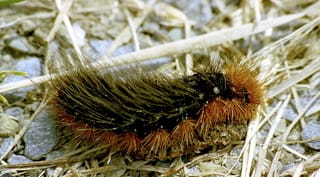 Photo: James K. Lindsey | Wood Tiger Moth(Parasemia plantaginis)Family: Arctiinae subfamily (Tiger and Lichen Moths) Size: 1.3 - 1.5 in (3 - 4 cm) Color: black Flits: Jun 01 - Jul 31 Status: native; uncommon Food source: nectar from low-growing plants Host: herbaceous plants Habitat: widely distributed at higher elevations throughout the Rocky Mountains These moths mostly fly during the day but females often fly at night. There are numerous named distinct forms of the Wood Tiger Moth. The extent of the markings and spots on the forewing and hindwing are variable between forms. Males from mountain populations generally have some white on the hindwing. Females tend to have yellow to red on the upper portions of their hindwings. Info Photos |
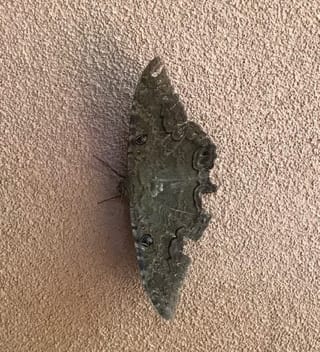 Photo: Chick Keller 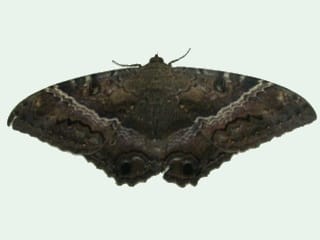 Photo: bkovarkez  Photo: Clifton Albrecht | Black Witch, Mariposa de la Muerte(Ascalapha odorata)Family: Erebidae (Erebid Moths) Size: 4.5 - 6.5 in (11 - 17 cm) Color: black, brown Flits: Jan 01 - Oct 15 Status: native; common Food source: nectar, sap, and juice of fallen fruit Host: cassia and catclaw Habitat: not a habitat specialist; rests on building during the day The Black Witch is the largest moth in the continental United States and some resemblance to a small bat. Its wings are dark brown with wavy brown or black lines and a spot near the leading edge of the forewing that is shaped like a comma or numeral nine. Under certain circumstances, iridescent tinges of color may be seen around the spots and lines. Males are smaller than females and darker in color (top photo). Females have a distinctive undulating white bar crossing the wings (middle photo). The Black Witch is nocturnal and has an aura of darkness and misfortune associated with it. It is considered to be a harbinger of death or bad luck in many countries including Mexico. Alternatively, if you see a Black Witch after someone has died, it is interperted as meaning that the person has returned to bid you farewell. Info Photos |
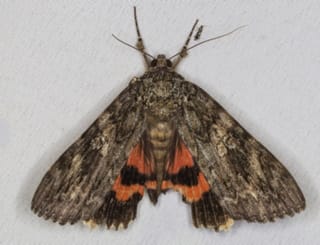 Photo: Greg Lasley 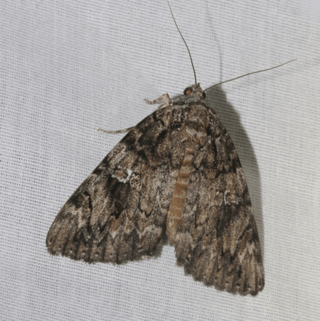 Photo: James Bailey 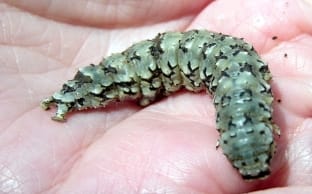 Photo: Pennsylvania Dept of Conservation | Ilia Underwing(Catocala ilia)Family: Erebidae (Erebid Moths) Size: 2.6 - 3.2 in (7 - 8 cm) Color: black, brown Flits: Jun 15 - Sep 15 Status: native; common Food source: nectar, tree sap Host: wide range of plants including foliage of trees, shrubs and grasses Habitat: often hide in protected places such as under underman-made structures during the day The Underwing Moths are mostly dull-colored with several species having brightly colored hindwings. The mottled forewings are excellent camouflage when at rest on a tree trunk and holding the wings in a tent-like position. The forewings may have large white spots in the middle. Info Photos |
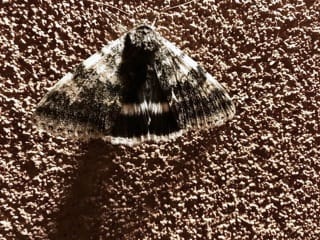 Photo: Chick Keller 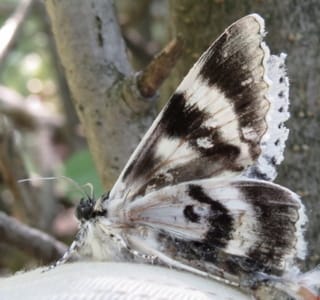 Photo: butterflies/white_underwing_side.jpg by Charlotte Bill 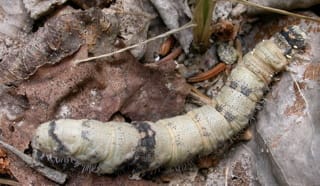 Photo: Colin D. Jones | White Underwing, Forsaken Underwing, Relict Underwing(Catocala relicta)Family: Erebidae (Erebid Moths) Size: 2.7 - 3.1 in (7 - 8 cm) Color: black, brown Flits: Jul 01 - Sep 30 Status: native; uncommon Food source: nectar Host: poplar, aspen, and willow Habitat: riparian zones along water; aspen and cottonwood forests The White Underwing is the only underwing in North America with black and white bands on the hindwing. Its forewings are white to cream with grayish black to dark brown patterns. The bottom of the wings have black and white bands. It has stout body covered with white hairs and thin antennae. This moth is nocturnal and will come to both light and sugar baits. The caterpillars tend to eat at night and hide during the day. Info Photos |
 Photo: Greg Lasley  Photo: Chick Keller 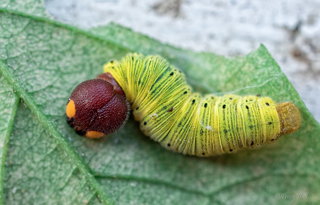 Photo: Tracy Hall | Silver-spotted Skipper(Epargyreus clarus)Family: Hesperidiidae (Skippers) Size: 1.8 - 2.4 in (4 - 6 cm) Color: brown Flits: May 01 - Sep 30 Status: native; common Food source: nectar from flowers including milkweed, red clover, and thistles Host: New Mexico locust Habitat: disturbed and open woods, foothill stream courses Prominent large, splashy, silver mark on underside of hindwings. Info Photos |
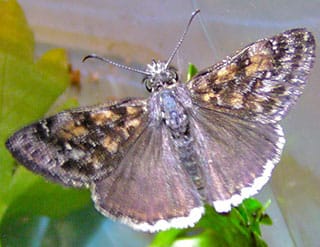 Photo: Earl Hoffman 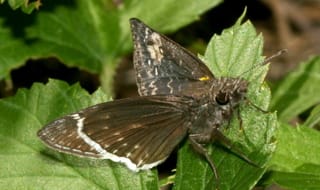 Photo: © Kim Davis and Mike Stange | Funereal Duskywing(Erynnis funeralis)Family: Hesperidiidae (Skippers) Size: 1.3 - 1.8 in (3 - 4 cm) Color: black, brown Flits: May 01 - Sep 30 Status: native; uncommon Food source: nectar from flowers Host: legumes including New Mexican locust, bur clover, deerweed, desert ironwood, and vetch Habitat: deserts, arid lowlands, roadsides Wings are black or dark brown with white hindwing fringes. Its forewing is narrow and pointed, and the hindwing somewhat triangular. It is named for its dark coloration. Info Photos |
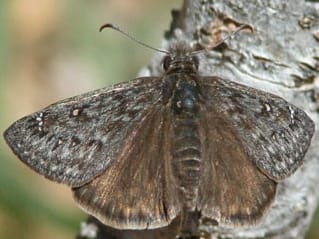 Photo: Selvi Viswanathan 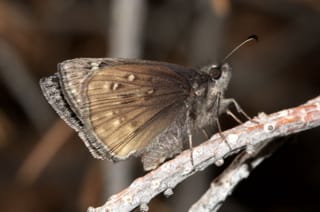 Photo: © Kim Davis and Mike Stangeland 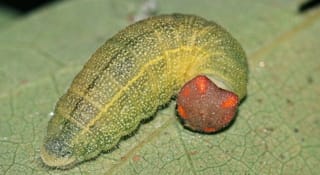 Photo: Todd Stout | Rocky Mountain Duskywing(Erynnis telemachus)Family: Hesperidiidae (Skippers) Size: 1.4 - 1.8 in (3 - 4 cm) Color: gray Flits: Apr 01 - Jul 30 Status: native; common Food source: flower nectar Host: Gambel oak Habitat: open areas near woods Gray forewings, brownish hindwings. Our most common duskywing, one of four that even experts have trouble telling apart. Info Photos |
 Photo: Greg Lasley  Photo: © Jim & Lynne Weber | Western Branded Skipper(Hesperia colorado)Family: Hesperidiidae (Skippers) Size: 0.9 - 1.4 in (2 - 3 cm) Color: orange Flits: Jun 15 - Aug 15 Status: native; uncommon Food source: nectar from asters and goldenrods as well as other flowers Host: grasses Habitat: open areas near forests and meadows The species is found across the globe with slightly different appearance depending on the particular geographical region. Thus there are several different recognized subspecies. In addition, Hesperia colorado is considered an entirely different species than the Common Branded Hairstreak Hesperia comma which looks similar but is darker in color. Info Photos |
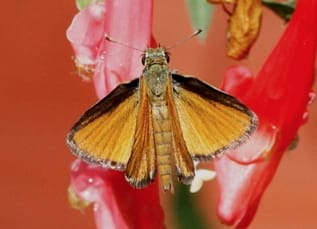 Photo: Selvi Viswanathan 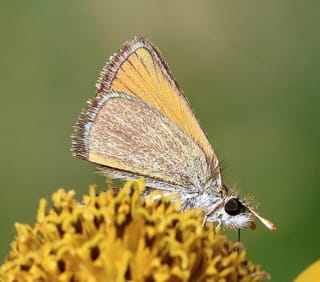 Photo: Alan Schmierer 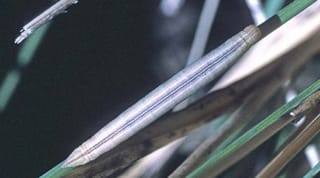 Photo: Jim P. Brock | Edward's Skipperling(Oarisma edwardsii)Family: Hesperidiidae (Skippers) Size: 0.9 - 1.1 in (2 - 3 cm) Color: orange Flits: Jun 01 - Sep 01 Status: native; uncommon Food source: flower nectar Host: sedges and grasses Habitat: grassy oak savannas Edward's Skipperlings are known for their rapid, darting flight. The tips of their antennas have a narrow hook-like projection. Their wings have white fringes. Info Photos |
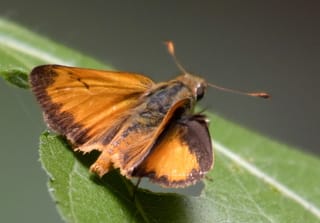 Photo: Steven Mlodinow 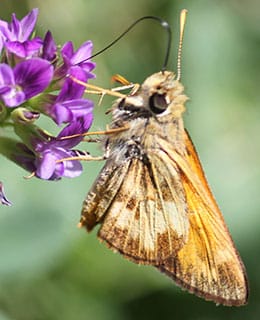 Photo: Rozelle Wright  Photo: Todd Stuart | Taxiles Skipper(Poanes taxiles)Family: Hesperidiidae (Skippers) Size: 1.3 - 1.7 in (3 - 4 cm) Color: orange Flits: May 01 - Sep 30 Status: native; uncommon Food source: nectar from flowers Host: grasses Habitat: valley bottoms, high-plains cottonwood groves, shady areas The sexes are dimporphic, with the males having yellow-orange colored wings with brown edges. Females are generally darker, with gray on the underwing. Its range extends from South Dakota and Nebraska south through the southern Rocky Mountains to central Mexico. Info Photos |
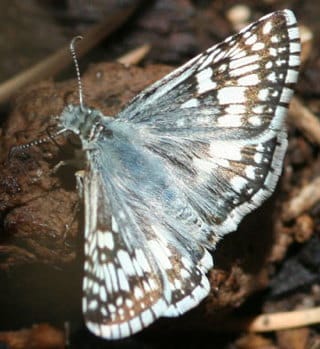 Photo: Selvi Viswanathan 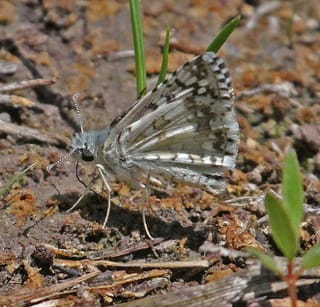 Photo: Jerry Oldenettel 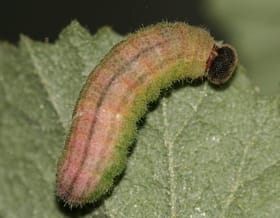 Photo: Todd Stout | Common Checkered Skipper, Checkered Skipper(Pyrgus communis)Family: Hesperidiidae (Skippers) Size: 1 - 1.5 in (3 - 4 cm) Color: black, gray Flits: May 15 - Sep 15 Status: native; common Food source: nectar from white-flowered composites Host: mallow family Habitat: open, sunny places with low vegetation and some bare soil Male has blue-gray body, while female has black body. Found both at high and low elevations. Info Photos |
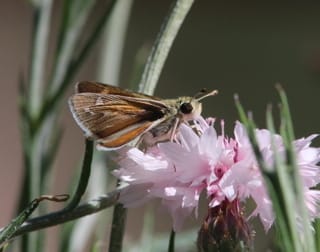 Photo: Selvi Viswanathan 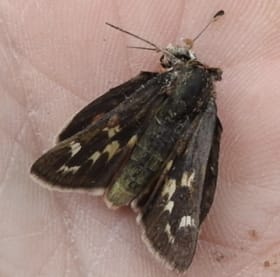 Photo: Sam Kieschnick  Photo: Selvi Viswanathan | Uncas Skipper(Hesperia uncas)Family: Hesperiidae (Skippers) Size: 1.1 - 1.6 in (3 - 4 cm) Color: black, brown Flits: May 15 - Aug 01 Status: native; common Food source: flower nectar Host: blue grama grass and needlegrass Habitat: open woodland, short grass areas The Uncas Skipper larvae build themselves shelters out of silk and plant materials. These shelters are expanded as the larvae grows. The adults are very strong fliers. They have such a fast wing beat that they can appear to be just a blur to the human eye. These butterflies only live for about three weeks and lose scales as they age. This causes their wing patterns to slowly disappear and the wings themselves to become duller. Info Photos |
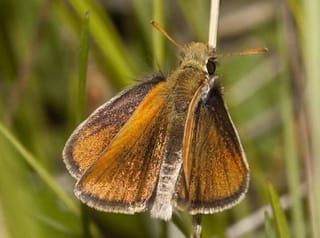 Photo: Bill Bouton 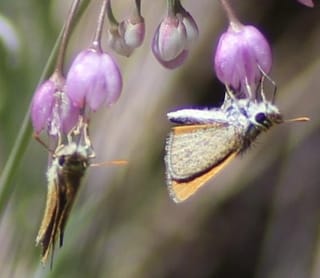 Photo: Blaire Bradley | Garita Skipperling, Western Skipperling(Oarisma garita)Family: Hesperiidae (Skippers) Size: 0.8 - 1.1 in (2 - 3 cm) Color: orange Flits: Jun 01 - Aug 01 Status: native; uncommon Food source: flower nectar Host: various grasses Habitat: higher montane open grasslands These small butterflies are orange brown above and under the forewings but gray with orange margins on the underside of the hindwings. They are weak flyers. Females lay their eggs on grass stems. Larvae are light green with a white stripes. They hibernate in their fourth stage. Info Photos |
 Photo: © Bill Bouton  Photo: © Bill Bouton | Snow's Skipper(Paratrytone snowi)Family: Hesperiidae (Skippers) Size: 1.1 - 1.4 in (3 - 4 cm) Color: brown Flits: Jul 01 - Aug 15 Status: native; uncommon Food source: nectar; particularly of yellow and blue flowers Host: grasses Habitat: clearings in woodlands and along streams This skipper is coppery brown all over with black markings on males. Info Photos |
 Photo: Joshua Smith 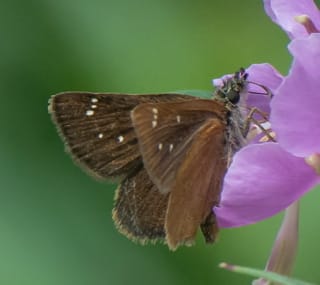 Photo: Marion Stelts | Russet Skipperling(Piruna pirus)Family: Hesperiidae (Skippers) Size: 1 - 1.1 in (3 - 3 cm) Color: brown Flits: May 15 - Aug 15 Status: native; uncommon Food source: flower nectar Host: wide leaved grasses Habitat: grassy area along streams and meadows Reddish brown underneath and dark brown on top with small white spots. They typically bask with forewings open to 45 degree and hindwings open wide. Like all Skippers they have a “bouncy” flight. Fully grown caterpillars hibernate. Info Photos |
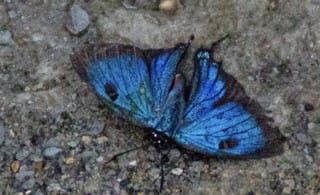 Photo: reiver 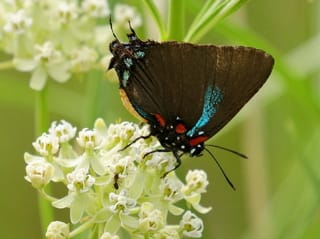 Photo: Bob Walker 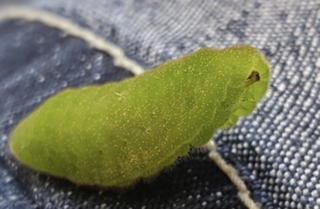 Photo: Arica Shields | Great Purple Hairstreak, Great Blue Hairstreak(Atlides halesus)Family: Lycaenidae (Gossamer-winged Butterflies) Size: 1.3 - 2 in (3 - 5 cm) Color: blue, brown Flits: Mar 01 - Dec 01 Status: native; common Food source: Nectar from flowers including goldenrod and wild plum Host: mistletoe Habitat: mixed woods infested with mistletoe Typical location: White Rock Canyon The Great Purple Hairstreak is a Neotropical species with a range from the southern parts of the US down through the Isthmus of Panama. Its primary coloration is bright blue above and brown with white, yellow, and red spots below. It has an orange abdomen. Larvae feed on the parasitic mistletoe but pupate under the bark of the parasitized tree. Info Photos |
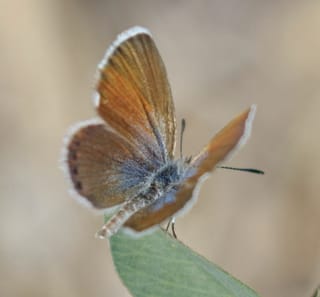 Photo: Marc Baily 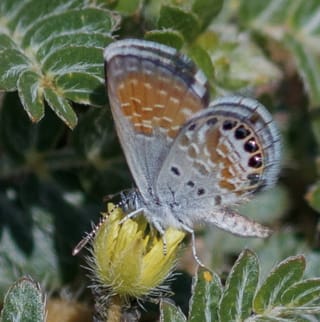 Photo: Marc Bailey 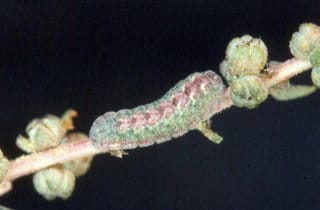 Photo: Jim P. Brock | Western Pygmy-blue(Brephidium exilis)Family: Lycaenidae (Gossamer-winged Butterflies) Size: 0.5 - 0.8 in (1 - 2 cm) Color: blue Flits: Jul 01 - Oct 15 Status: native; uncommon Food source: flower nectar Host: pigweed, saltbush, others in the goosefoot family Habitat: deserts, salt marshes, wasteland Smallest butterfly in the region. Upper-side of the wings copper with blue edges; underside blue with copper. Info Photos |
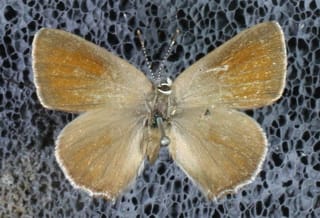 Photo: Museum of Comparative Zoology, Harvard 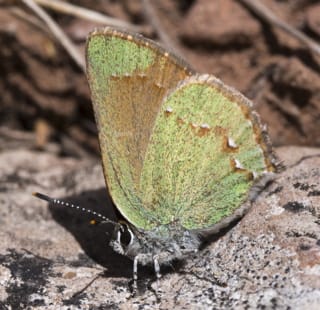 Photo: Robb Hannawacker | Western Green Hairstreak(Callophrys affinis)Family: Lycaenidae (Gossamer-winged Butterflies) Size: 1 - 1.1 in (3 - 3 cm) Color: green Flits: Mar 01 - Aug 01 Status: native; uncommon Food source: flower nectar Host: buckwheat Habitat: sagelands, often in lower mountains; open sunny slopes Typical location: White Rock Canyon Adults are tailless with variable coloring from gray to orange to orange-brown on green to yellow-green with typically only a little white. There have been six closely related subspecies described with Callophrys affinis agama depicted here. Caterpillars each leaves and flowers. The chrysalids hibernate over winter. Info Photos |
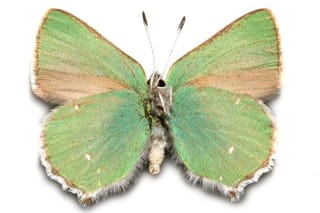 Photo: Jim P. Brock 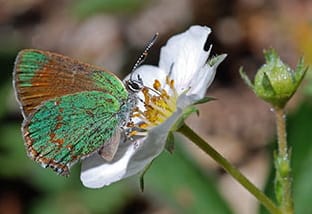 Photo: Sally King 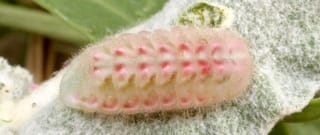 Photo: Jim P. Brock | Bramble Hairstreak, Coastal Green Hairstreak, Canyon Green Hairstreak, Lotus Hairstreak(Callophrys dumetorum)Family: Lycaenidae (Gossamer-winged Butterflies) Size: 0.9 - 1.1 in (2 - 3 cm) Color: green Flits: Jun 15 - Sep 01 Status: native; common Food source: flower nectar Host: wild buckwheats Habitat: forests, meadows and fields, canyons, shrub and brushlands Brown area on underside of the forewing differentiates it from Juniper Hairstreak. Info Photos |
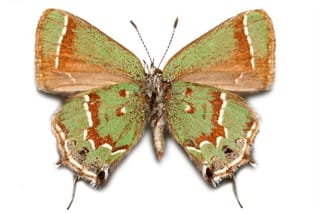 Photo: Jim P. Brock 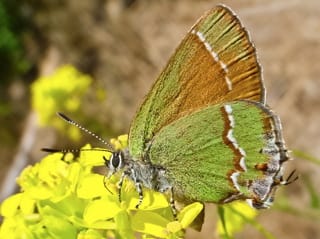 Photo: cyric 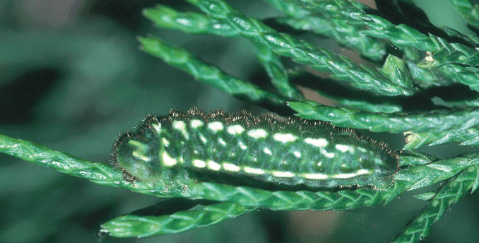 Photo: Connecticut Agricultural Experimental Station | Juniper Hairstreak(Callophrys gryneus)Family: Lycaenidae (Gossamer-winged Butterflies) Size: 0.9 - 1.1 in (2 - 3 cm) Color: green Flits: Mar 15 - Oct 30 Status: native; common Food source: nectar from various flowers including milkweed, wild carrot, dogbane, butterflyweed, white sweet clover Host: junipers Habitat: fields, bluffs, open wooded areas Small, green with rust and white bands across hindwings. There are many regional variations often considered subspecies. However, populations in the same area that live on different host plants, may look different. In addition, cross-breeding between subspecies in the area has been reported. Info Photos |
 Photo: Mark Rosenstein  Photo: Selvi Viswanathan 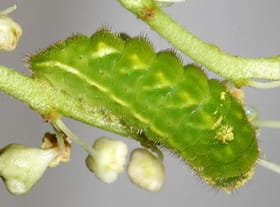 Photo: Nicky Davis | Spring Azure(Celastrina ladon)Family: Lycaenidae (Gossamer-winged Butterflies) Size: 0.8 - 1.1 in (2 - 3 cm) Color: blue Flits: Mar 15, 2000 - Sep 30, 0000 Status: native; common Food source: flower nectar Host: flowering woody shrubs such as dogwood Habitat: woodland areas particularly near openings and water The Spring Azure is recognized as part of the “Spring Azure Complex” of small blue butterflies. The categorization of the different potential species and subspecies within the complex is still in dispute. Northern New Mexico has “spring azures” all spring and summer. These butterflies are most active from the middle of the afternoon until dusk. Their flight is week and usually low to the ground. Info Photos |
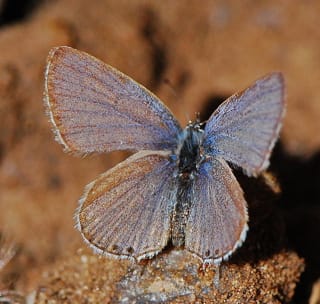 Photo: Jerry Oldenettel 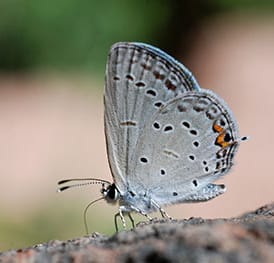 Photo: Sally King 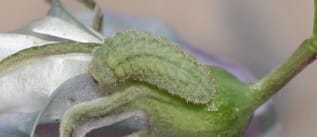 Photo: Todd Stout | Western Tailed-Blue(Cupido amyntula)Family: Lycaenidae (Gossamer-winged Butterflies) Size: 0.9 - 1.1 in (2 - 3 cm) Color: blue Flits: May 15 - Sep 01 Status: native; common Food source: flower nectar Host: locoweed, peavine, vetch Habitat: open areas with low shrubs including meadows and open woodland One of our smallest butterflies. Info Photos |
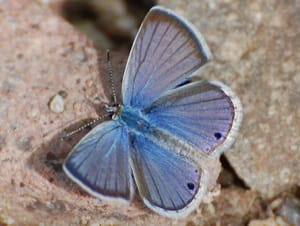 Photo: Jerry Oldenettel 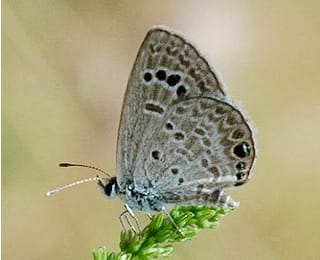 Photo: Catherine Cook 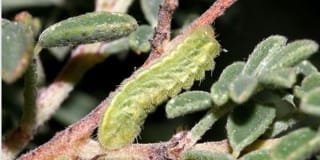 Photo: Jim P. Brock | Reakirt's Blue(Echinargus isola)Family: Lycaenidae (Gossamer-winged Butterflies) Size: 0.8 - 1.1 in (2 - 3 cm) Color: blue, brown Flits: Mar 01 - Oct 30 Status: native; common Food source: flower nectar from a variety of herbs Host: legumes Habitat: fields, desert, weedy areas, creek sides Underwing has a band of bold black spots rimmed with white. The base of the wing sports two black spots. Info Photos |
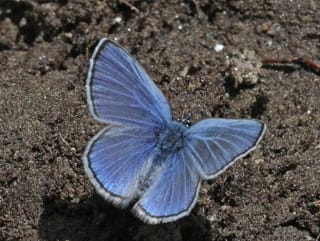 Photo: Jerry Oldenettel 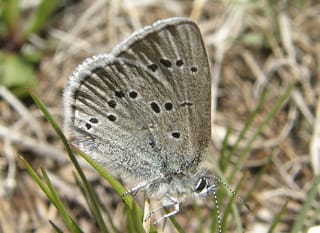 Photo: Yvonne Keller 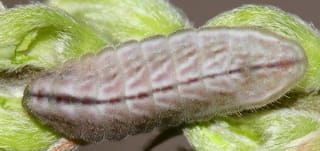 Photo: Nicky Davis | Silvery Blue(Glaucopsyche lygdamus)Family: Lycaenidae (Gossamer-winged Butterflies) Size: 0.9 - 1.3 in (2 - 3 cm) Color: blue, gray Flits: Jun 01 - Aug 15 Status: native; common Food source: nectar from flowers including asters Host: lupines, deervetch, clovers, other legumes Habitat: variety of locations including open woods, road edges, rocky moist woods, and brushy fields We have 10 species of blues. Silvery has rather plain undersides with a prominent row of dots parallel to the margins of the wings. Info Photos |
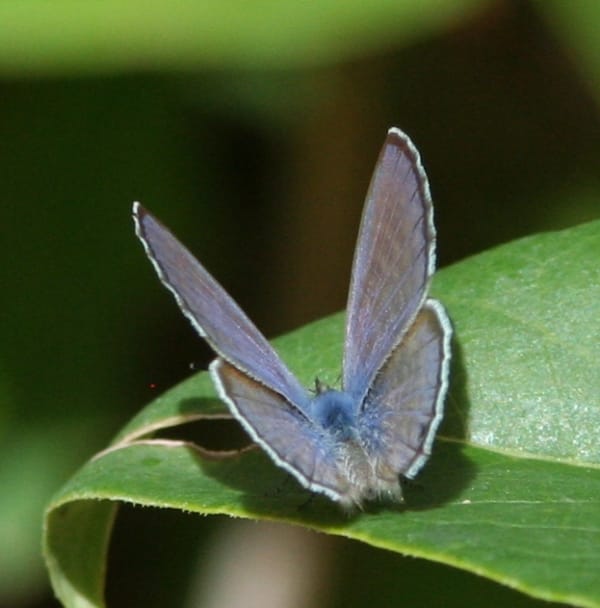 Photo: Selvi Viswanathan 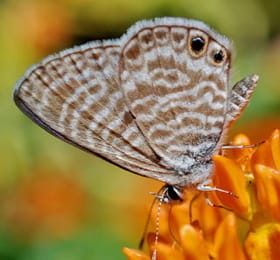 Photo: Sally King 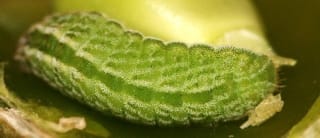 Photo: Todd Stout | Marine Blue(Leptotes marina)Family: Lycaenidae (Gossamer-winged Butterflies) Size: 0.9 - 1.1 in (2 - 3 cm) Color: blue Flits: May 01 - Sep 30 Status: native; common Food source: flower nectar Host: legumes Habitat: mesquite scrub, city gardens, desert Small, migratory. Underwings have brown/white wavy stripes. Info Photos |
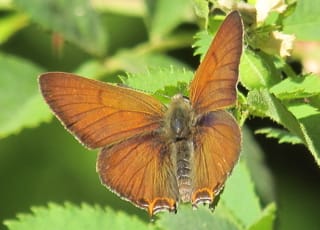 Photo: Jennifer Rycenga  Photo: Chick Keller | Tailed Copper(Lycaena arota)Family: Lycaenidae (Gossamer-winged Butterflies) Size: 1.1 - 1.4 in (3 - 3 cm) Color: orange Flits: Jul 01 - Sep 30 Status: native; common Food source: flower nectar Host: gooseberries, currants Habitat: open mixed woods, suburbs and towns Small orange butterfly with exquisite tails. Widespread but rare in our area. Info Photos |
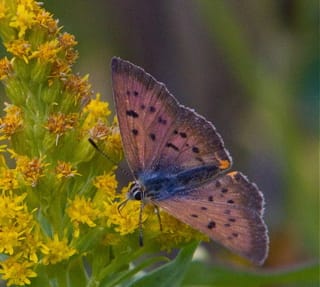 Photo: © Jim & Lynne Weber 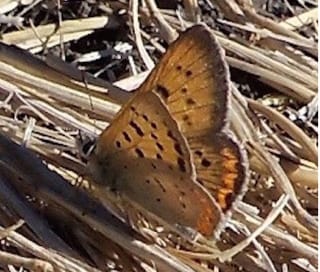 Photo: Di | Purplish Copper(Lycaena helloides)Family: Lycaenidae (Gossamer-winged Butterflies) Size: 1.1 - 1.5 in (3 - 4 cm) Color: orange, purple Flits: May 15 - Jul 15 and Aug 15 - Oct 01 Status: native; uncommon Food source: flower nectar Host: plants in the buckwheat and rose families Habitat: along roadsides and open wet areas Found throughout most of northern, western and central North America. Males are brown above with a tinge of purple that is refractive so than in bright sun it can appear much brighter (top photo). Females are orange above with strong, dark spots (bottom photo). May have up to two broods during the spring/summer. Overwinters as an egg. Info Photos |
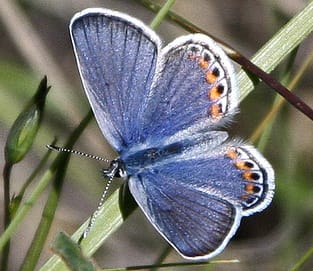 Photo: Mary Carol Williams 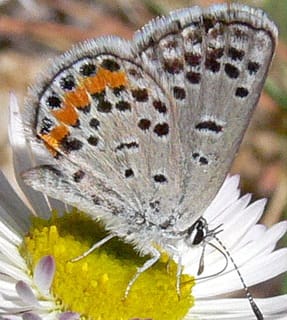 Photo: Sally King | Acmon Blue(Plebejus acmon, Icaricia acmon)Family: Lycaenidae (Gossamer-winged Butterflies) Size: 0.9 - 1.1 in (2 - 3 cm) Color: blue, brown Flits: May 01 - Oct 15 Status: native; common Food source: flower nectar Host: lupines, other members of the legume family Habitat: alpine slopes, mountain meadows and slopes, prairies, rocky outcrops, chaparral, and sagebrush Hindwings with bright orange merged dots. Males are blue; females are brown. Info Photos |
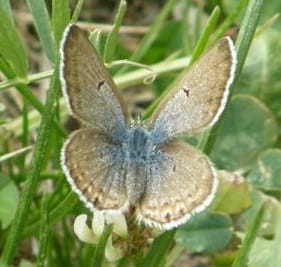 Photo: Yvonne Keller 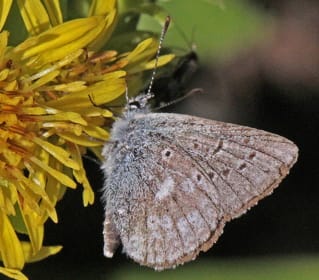 Photo: Jerry Oldenettel  Photo: Todd Stout | Arctic Blue , High-mountain Blue, Glandon Blue(Plebejus glandon, Plebejus aquilo)Family: Lycaenidae (Gossamer-winged Butterflies) Size: 0.9 - 1 in (2 - 3 cm) Color: blue Flits: Jun 01 - Sep 30 Status: native; common Food source: flower nectar Host: shooting star, rock jasmine Habitat: gravelly hills, alpine fields, and subalpine meadows Black dots on hindwings; commas on upper wings. Female shows varying amounts of brown or grey. Info Photos |
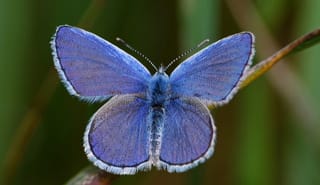 Photo: Brad Smith 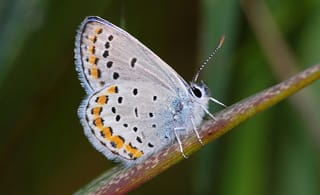 Photo: Brad Smith 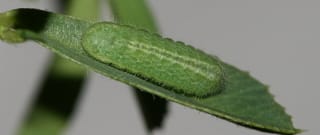 Photo: Todd Stout | Melissa Blue, Orange-bordered Blue(Plebejus melissa, Lycaeides melissa)Family: Lycaenidae (Gossamer-winged Butterflies) Size: 0.9 - 1.4 in (2 - 3 cm) Color: blue, brown Flits: May 01 - Sep 30 Status: native; common Food source: flower nectar Host: legumes, alfalfa, lupine Habitat: open, weedy areas Wings have a white edge, thin black line, and faint orange wash on the underside. Has two broods, but only one at higher elevation. One of the most widespread blues. Info Photos |
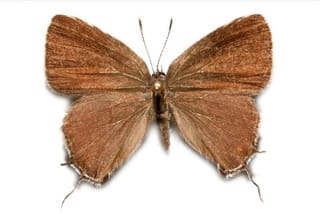 Photo: Jim P. Brock 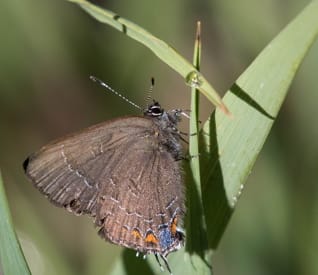 Photo: © Jim & Lynne Weber | Banded Hairstreak(Satyrium calanus)Family: Lycaenidae (Gossamer-winged Butterflies) Size: 1 - 1.3 in (3 - 3 cm) Color: brown Flits: Jul 01 - Aug 30 Status: native; uncommon Food source: nectar from milkweed, dogbane, daisies and other plants Host: oak, hickory and walnut Habitat: woodland clearings and canyons Banded Hairstreaks are primarily found in the Eastern portion of the US but can also be seen in areas around the Southern Rocky Mountains. They can be very variable in appearance. In general, males are brownish-black while females are more slate-colored. Info Photos |
 Photo: Jerry Oldenettel 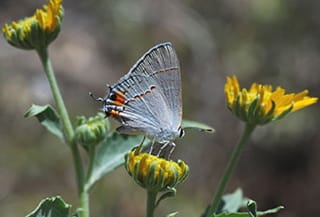 Photo: Sally King 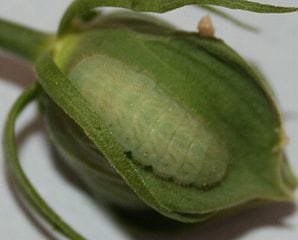 Photo: Meganmccarthy | Gray Hairstreak(Strymon melinus)Family: Lycaenidae (Gossamer-winged Butterflies) Size: 0.9 - 1.4 in (2 - 3 cm) Color: gray Flits: May 15 - Sep 01 Status: native; common Food source: nectar from many flowers including dogbane, milkweed, mint, goldenrod, and white sweet clover Host: oaks, strawberries, legumes, mallows Habitat: open sites, common in disturbed, weedy areas Upper side blue-gray with large red spot near tail. Underside of spring/fall form is dark gray, summer form is paler gray. Info Photos |
 Photo: Josip Loncaric  Photo: Whitney Cranshaw  Photo: Frank Peairs | Army Cutworm Moth, Miller Moth(Euxoa auxiliaris)Family: Noctuidae (Owlet Moths) Size: 1.6 - 1.8 in (4 - 5 cm) Color: black, brown Flits: Jun 15 - Jul 15 Status: native; common Food source: nectar from wildflowers Host: large number of plants, in particular small grains and vegetables Habitat: larvae hatch in low-lying grass and farmlands, adults migrate to and spend the summer at higher elevation; some adults return to lower elevation before winter The Army Cutworm’s nickname of “Miller Moth” comes from the fact that its wing scales rub off easily and cover everything like flour on a miller. It is considered to be a seasonal nuisance during the migration of the adults. The moths can enter homes through the smallest of cracks. Also the caterpillars are considered pests for oat and wheat crops. On the other hand, since up to 72% of a moth’s body weight is fat, it is a very rich food for predators such as bears, elk and deer. Info Photos |
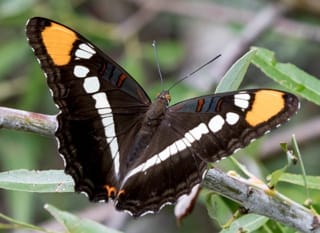 Photo: Graham Mark 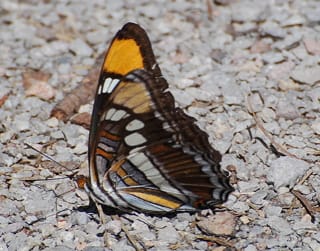 Photo: Jerry Oldenettel 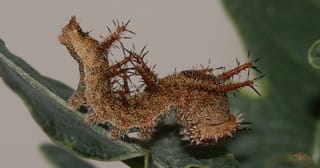 Photo: Todd Stout | Arizona Sister(Adelpha eulalia)Family: Nymphalidae (Brush-footed Butterflies) Size: 3 - 5 in (8 - 13 cm) Color: black Flits: Jun 01, 2000 - Aug 31, 0000 Status: native; common Food source: water and mud, rotting fruit, rarely nectar Host: Gambel oak Habitat: oak woodland, riparian canyons, mixed coniferous forests Black with bright orange spots on upper wing tips. Formerly listed as California Sister. Info Photos |
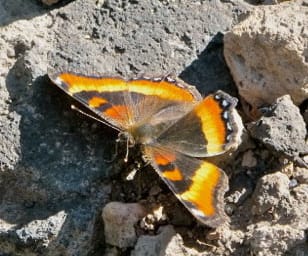 Photo: Beth Cortright 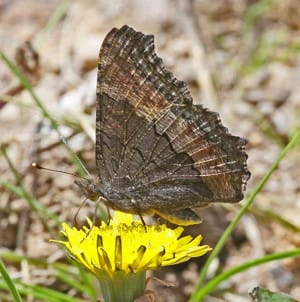 Photo: Jerry Oldenettel 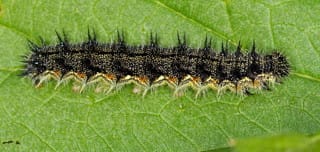 Photo: crgillette | Milbert's Tortoiseshell, Fire-rim tortoiseshell(Aglais milberti, Nymphalis milberti)Family: Nymphalidae (Brush-footed Butterflies) Size: 1.8 - 2 in (4 - 5 cm) Color: black Flits: May 15 - Oct 15 Status: native; common Food source: usually nectar from flowers, such as thistles, goldenrods, and lilacs, probably also sap and rotting Host: nettles Habitat: wet areas near woodlands, moist pastures Wide bright orange and cream band on outer wing margins. Upper elevations. Info Photos |
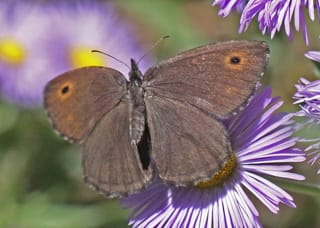 Photo: Jerry Oldenettel 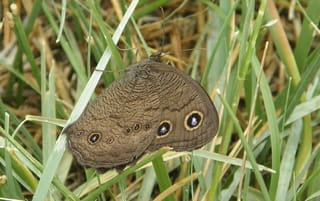 Photo: Chick Keller  Photo: Todd Stout | Small Wood Nymph, Dark Wood Nymph(Cercyonis oetus)Family: Nymphalidae (Brush-footed Butterflies) Size: 1.5 - 1.9 in (4 - 5 cm) Color: brown Flits: Jun 01 - Aug 15 Status: native; common Food source: flower nectar Host: grasses Habitat: dry chaparral, sagebrush, grasslands, scrub, open woodland, meadows Two large eyespots on underside of forewings with the top eyespot larger than lower. Info Photos |
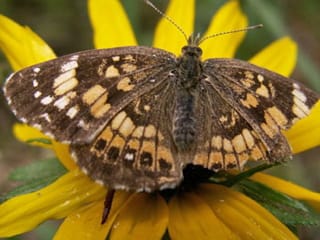 Photo: Yvonne Keller 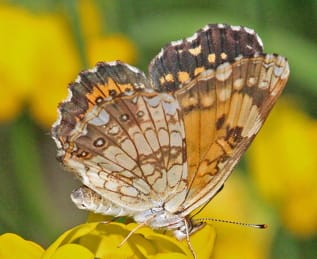 Photo: Jerry Oldenettel 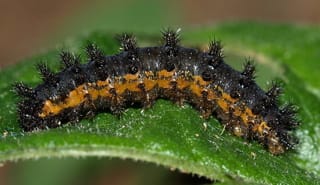 Photo: summerazure | Silvery Checkerspot, Streamside Checkerspot, Nycteis crescent(Chlosyne nycteis)Family: Nymphalidae (Brush-footed Butterflies) Size: 1.4 - 2 in (3 - 5 cm) Color: black, brown Flits: Jun 01 - Aug 15 Status: native; common Food source: nectar from red clover, dogbane, and milkweed Host: sunflower family Habitat: streamsides, meadows, forest openings Intensely patterned orange and black butterfly. Has silver dots on the upper hindwing marginal spots. Info Photos |
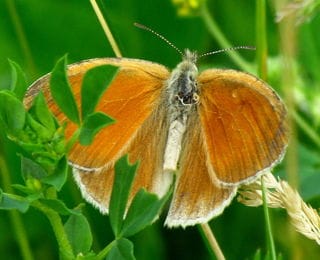 Photo: D. Gordon E. Robertson 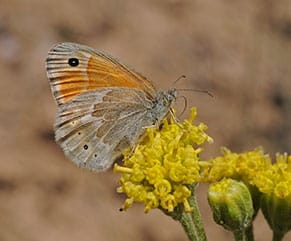 Photo: Sally King | Common Ringlet, Ochre Ringlet, Large Heath(Coenonympha tullia)Family: Nymphalidae (Brush-footed Butterflies) Size: 1 - 1.9 in (3 - 5 cm) Color: orange Flits: May 15 - Aug 15 Status: native; common Food source: flower nectar Host: grasses Habitat: Grassy areas in a wide variety of habitats, including fields, meadows, and grasslands Flies low. Hindwing underside is gray. Flashes orange when flies. Info Photos |
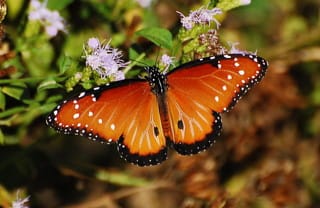 Photo: Jerry Oldenettel 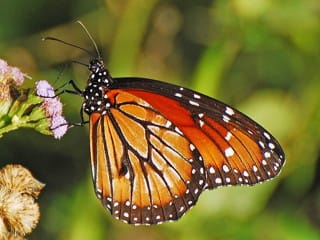 Photo: Jerry Oldenettel 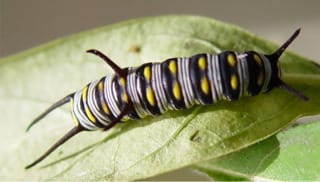 Photo: John Herrick | Queen(Danaus gilippus)Family: Nymphalidae (Brush-footed Butterflies) Size: 3 - 23.4 in (8 - 59 cm) Color: orange Flits: May 01 - Sep 30 Status: native; common Food source: nectar from flowers including milkweeds, fogfruit, and shepherd's needle Host: milkweeds Habitat: open, sunny areas including fields, deserts, roadsides, pastures, dunes, washes, and waterways Queens in the southwest have pale veins on the upper side of the hindwings. Info Photos |
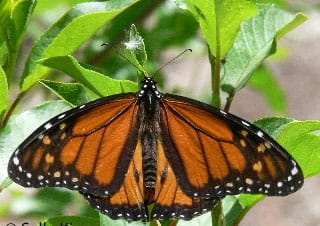 Photo: Sally King 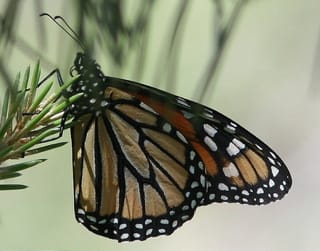 Photo: Selvi Viswanthan 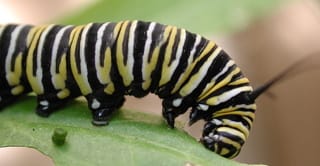 Photo: Pseudopanax | Monarch(Danaus plexippus)Family: Nymphalidae (Brush-footed Butterflies) Size: 3.4 - 4.9 in (9 - 12 cm) Color: orange Flits: Jun 15 - Oct 25 Status: native; common Food source: nectar from all milkweeds and a variety of other flowers Host: milkweeds Habitat: fields, meadows, weedy areas, and roadsides Largest butterfly that flits here. Occasional stray during migration. Deep orange in color with black bands and two rows of white dots around margins of wings. Info Photos |
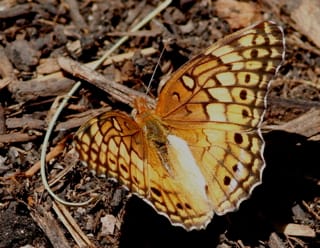 Photo: Selvi Viswanathan 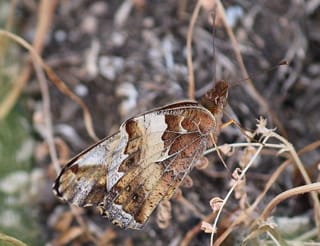 Photo: jgrantz  Photo: Dave Govoni | Variegated Fritillary(Euptoieta claudia)Family: Nymphalidae (Brush-footed Butterflies) Size: 1.8 - 2.3 in (4 - 6 cm) Color: orange, yellow Flits: May 01 - Sep 30 Status: native; common Food source: nectar from several plant species including butterflyweed, common milkweed, dogbane, peppermint, and clover Host: violets, plantain, flax Habitat: meadows and fields, grasslands, suburbs and towns Dull brownish orange overall with flashes of bright orange under forewing when flying. Info Photos |
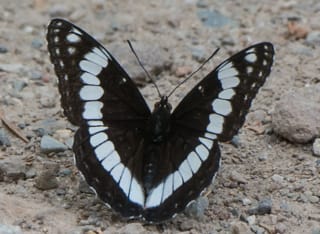 Photo: Marion Stelts 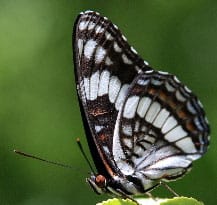 Photo: Sally King  Photo: Jim P. Brock | Weidemeyer's Admiral(Limenitis weidemeyerii, Basilarchia weidemeyerii)Family: Nymphalidae (Brush-footed Butterflies) Size: 2.8 - 3.4 in (7 - 9 cm) Color: black Flits: Jun 01 - Aug 31 Status: native; common Food source: tree sap, carrion, flower nectar Host: willows, aspens, cottonwoods Habitat: forest, streamsides in coniferous forests, aspen groves, small towns, suburbs Black with wide V-shaped band across upper wings. Patrols trail and road clearings in forests. Will soar high among the trees but comes down to perch on trees, usually about 7 to 15 ft (2 to 4.5 m) above the ground. Info Photos |
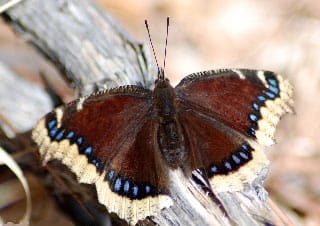 Photo: Sally King 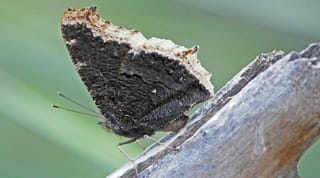 Photo: Jerry Oldnettel 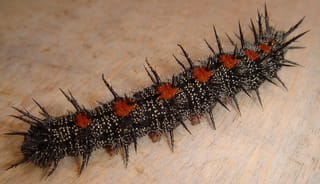 Photo: Wthrower | Mourning Cloak, Camberwell Beauty(Nymphalis antiopa)Family: Nymphalidae (Brush-footed Butterflies) Size: 2.9 - 2.4 in (7 - 6 cm) Color: black, brown Flits: Feb 01 - Nov 30 Status: native; common Food source: tree sap, rotting sap, and occasionally flower nectar Host: willows, cottonwoods, Siberian elm Habitat: woods, openings, parks, and suburbs, especially near water Velvety black with bright yellow band on upper hindwings. Info Photos |
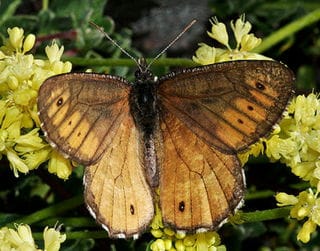 Photo: © Bill Bouton 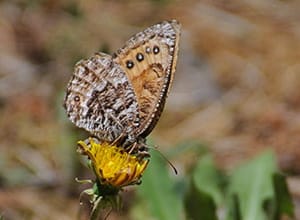 Photo: Sally King | Chryxus Arctic, Brown Arctic(Oeneis chryxus, Oeneis strigulosa)Family: Nymphalidae (Brush-footed Butterflies) Size: 1.8 - 2 in (4 - 5 cm) Color: brown Flits: May 15 - Sep 01 Status: native; common Food source: flower nectar Host: grasses, sedges Habitat: open grassy, rocky, and woodland areas Hindwing is a mottled dark brown with shades of white. Forewing is a lighter orange color and has a small eyespot. Info Photos |
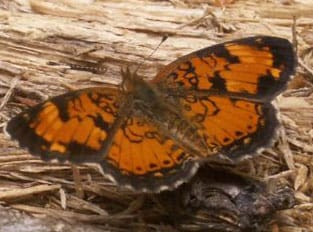 Photo: Yvonne Keller 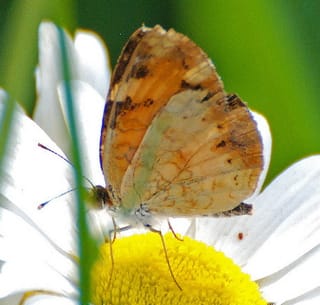 Photo: Jerry Oldenettel | Northern Crescent(Phyciodes cocyta, Phyciodes selenis)Family: Nymphalidae (Brush-footed Butterflies) Size: 1 - 1.5 in (3 - 4 cm) Color: orange Flits: Jun 01 - Jul 30 Status: native; common Food source: nectar from flowers of dogbane, fleabane, and white clover Host: asters Habitat: moist open areas in rocky places, wooded streams Deep orange with black wing margins and frilly lines around body. Info Photos |
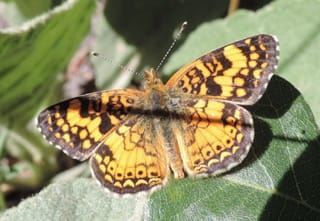 Photo: Chick Keller .jpg) Photo: Donald Hobern 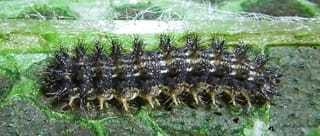 Photo: Todd Stuart | Mylitta Crescent(Phyciodes mylitta)Family: Nymphalidae (Brush-footed Butterflies) Size: 1.1 - 1.5 in (3 - 4 cm) Color: orange Flits: May 15 - Sep 30 Status: native; common Food source: flower nectar Host: thistles Habitat: fields, meadows, roads, vacant lots, parks Flies low. Info Photos |
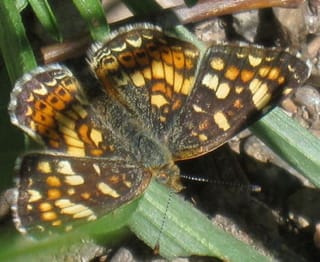 Photo: Jennifer Macke 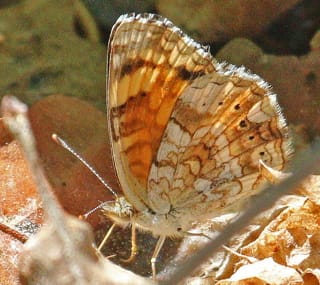 Photo: Jerry Oldenettel | Field Crescent(Phyciodes pulchella, Phyciodes campestris)Family: Nymphalidae (Brush-footed Butterflies) Size: 1 - 1.8 in (3 - 4 cm) Color: orange Flits: Jul 01 - Aug 31 Status: native; common Food source: flower nectar Host: asters Habitat: open areas, fields, and streamsides Antenna tips are dark brown or black while other Crescents usually have orange tips. Info Photos |
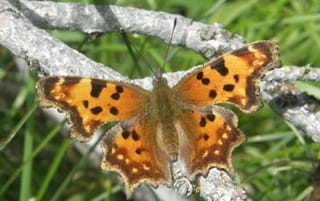 Photo: Chick Keller 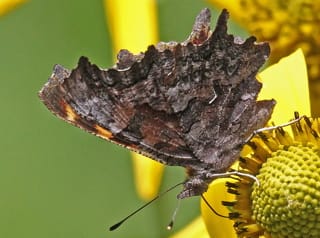 Photo: Jerry Oldenettel | Green Comma, Green Anglewing, Faunus Anglewing(Polygonia faunus)Family: Nymphalidae (Brush-footed Butterflies) Size: 1.8 - 2.5 in (4 - 6 cm) Color: orange Flits: Feb 01 - Dec 15 Status: native; common Food source: flower nectar, dung, carrion Host: willows, currants, alders Habitat: forests, mountain streamsides, canyons Wide dark bands and mid-wing spots on hindwings. Often seen on sunny days in winter. Info Photos |
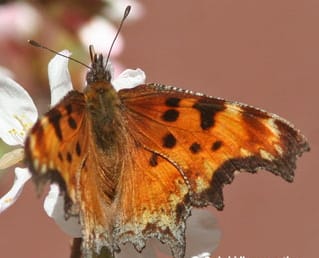 Photo: Selvi Viswanathan 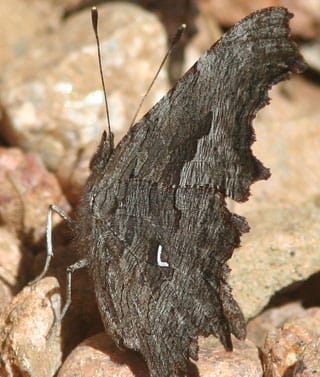 Photo: Selvi Viswanathan 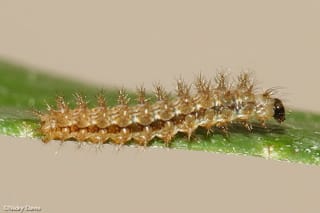 Photo: Nicky Davis | Hoary Comma(Polygonia gracilis)Family: Nymphalidae (Brush-footed Butterflies) Size: 1.4 - 1.6 in (3 - 4 cm) Color: orange Flits: Feb 01 - Dec 15 Status: native; common Food source: sap and nectar from flowers of sweet everlasting among others Host: currants, gooseberries Habitat: from foothills to tree line, woodland streamsides, brushlands Light band lacking a mid-wing spot on hindwings. Often seen on sunny days in winter. Info Photos |
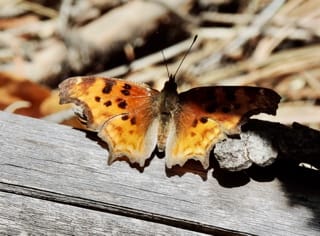 Photo: Chick Keller 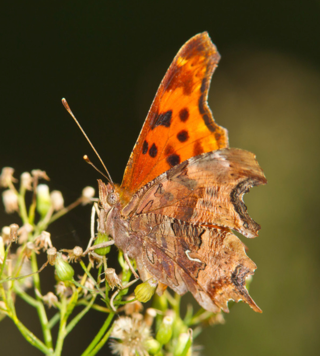 Photo: Greg Lasley 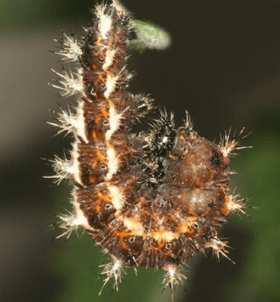 Photo: Todd Stout | Satyr Comma(Polygonia satyrus)Family: Nymphalidae (Brush-footed Butterflies) Size: 1.8 - 2.5 in (4 - 6 cm) Color: orange Flits: Jun 01 - Sep 30 Status: native; common Food source: tree sap and flower nectar Host: various types of nettles Habitat: wooded areas, field edges, and along water The top of the wings is bright orange — both the forewing and hindwing have black spots. The underside of the wings is golden brown with a silver comma in the center of the hindwing. Adults can hibernate. Males are active in the late afternoon when looking for females. Females lay their eggs on the underside of needle leaves. The caterpillars no only eat the leaves but use them as a shelter. Info Photos |
 Photo: Josip Loncaric 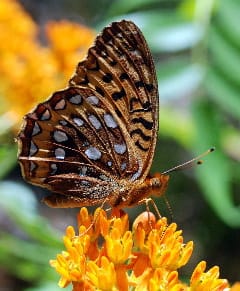 Photo: Sally King | Northwestern Fritillary(Speyeria hesperis)Family: Nymphalidae (Brush-footed Butterflies) Size: 2 - 2.8 in (5 - 7 cm) Color: orange Flits: May 15 - Sep 30 Status: native; common Food source: nectar from Gaillardia, rabbitbrush, purple mints, shrub cinquefoil, and others Host: violets Habitat: forest openings, meadows, and open hillsides Formerly Atlantis Fritillary. A mid-size butterfly with silver spots on underwings and a dark shadow on upper forewings. We have three fritillaries that are hard to tell apart. Northwestern is the most common. Info Photos |
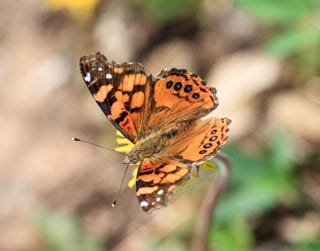 Photo: Marc Bailey 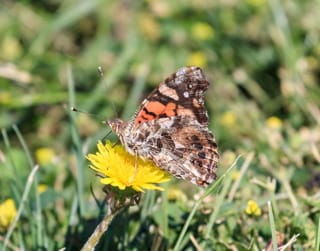 Photo: Marc Bailey 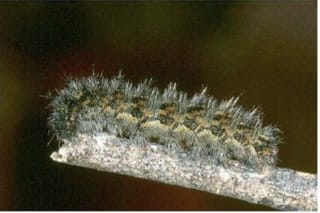 Photo: Jim P. Brock | West Coast Lady(Vanessa annabella)Family: Nymphalidae (Brush-footed Butterflies) Size: 1.5 - 2.3 in (4 - 6 cm) Color: orange Flits: Jun 01 - Aug 31 Status: native; uncommon Food source: flower nectar Host: a variety of mallows Habitat: gardens, fields, disturbed areas Decked out in orange and brown and commonly known as one of the "painted ladies" in the area. It can be distinguished from the other two by the lack of obvious ventral eyespots. Info Photos |
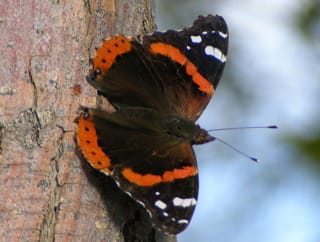 Photo: Jerry Oldenettel 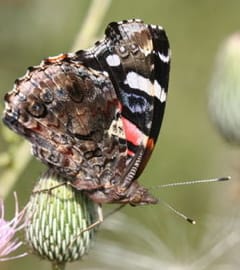 Photo: Randy Snyder 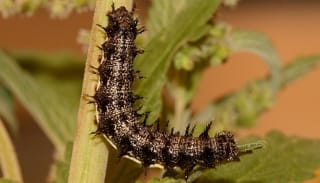 Photo: Todd Stout | Red Admiral(Vanessa atalanta)Family: Nymphalidae (Brush-footed Butterflies) Size: 2.3 - 3.3 in (6 - 8 cm) Color: black, orange Flits: Jun 01 - Aug 15 Status: native; common Food source: prefers sap flows on trees, fermenting fruit, and bird droppings, nectar from milkweed, red clover, Host: nettles, hops Habitat: moist woods, yards, parks, marshes, seeps, moist fields Brilliant red bands across forewings and hindwing margins. Info Photos |
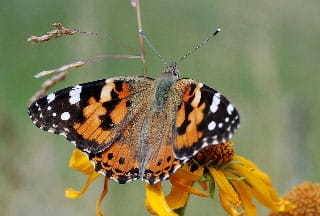 Photo: Sally King 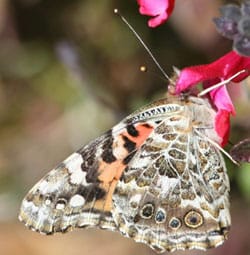 Photo: Selvi Viswanathan 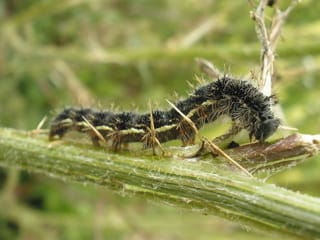 Photo: MIRROR | Painted Lady, Cynthia Cardui(Vanessa cardui)Family: Nymphalidae (Brush-footed Butterflies) Size: 2 - 2.3 in (5 - 6 cm) Color: orange Flits: Mar 01 - Nov 15 Status: native; common Food source: nectar from composites, especially thistles, also aster, cosmos, red clover, buttonbush, privet, and Host: thistles, mallow family including cheeseweed Habitat: numerous sites, especially in open or disturbed soils including gardens, old fields The most common of the three ladies. Innermost chevron on shoulder is white. Has four dots along base of hindwings. Info Photos |
 Photo: Jerry Oldenettel 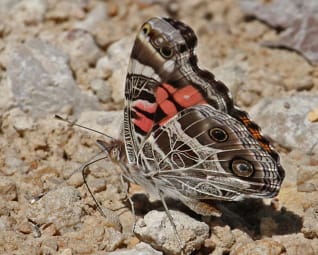 Photo: Jerry Oldenettel  Photo: Judy Gallagher | American Lady(Vanessa virginiensis)Family: Nymphalidae (Brush-footed Butterflies) Size: 1.8 - 2.6 in (4 - 7 cm) Color: orange Flits: Jun 01 - Sep 30 Status: native; common Food source: nectar from flower including dogbane, aster, goldenrod, marigold, milkweed, and vetch Host: pearly everlasting, other plants of the sunflower family Habitat: open places with low vegetation including parks, vacant lots, forest edges Two large eyespots on upper hindwings. Info Photos |
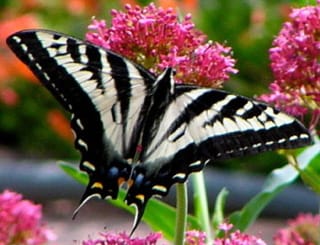 Photo: Earl Hoffman 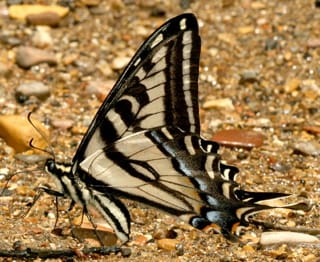 Photo: © Kim Davis and Mike Stangeland 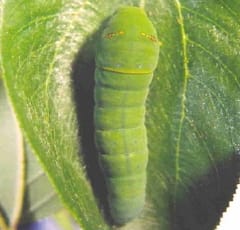 Photo: | Pale Swallowtail, Pallid Swallowtail(Papilio eurymedon)Family: Papiliondae (Swallowtails) Size: 2.5 - 3.5 in (6 - 9 cm) Color: white Flits: May 15 - Sep 01 Status: native; common Food source: flower nectar Host: alders Habitat: foothills, open woodlands, chaparral, streamsides Similar to the Western Tiger Swallowtail but paler in color. Info Photos |
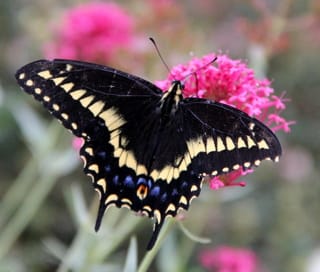 Photo: Blaire Bradley 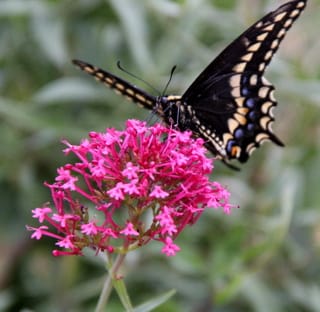 Photo: Blaire Bradley 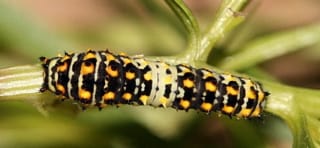 Photo: Todd Stout | Old World Swallowtail, Baird's Old World Swallowtail(Papilio machaon, Papilio machaon bairdii)Family: Papiliondae (Swallowtails) Size: 2.5 - 3 in (6 - 8 cm) Color: black Flits: Apr 15, 2000 - Sep 15, 0000 Status: native; uncommon Food source: flower nectar Host: sagebrush and others in the genus Artemisia Habitat: grasslands, open meadows Baird’s Old World Swallowtail is one of several subspecies of Papilio machaon. The distribution of the different subspecies is ill-defined. Baird’s is found throughout the western US with the black form shown here prevailing in the southern regions. The yellow form is predominate further north. Info Photos |
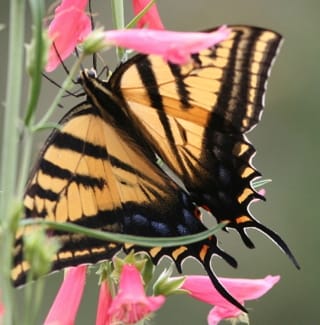 Photo: Selvi Viswanathan 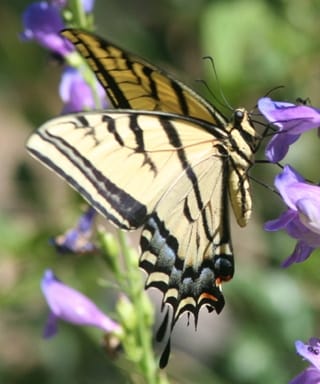 Photo: Selvi Viswanathan 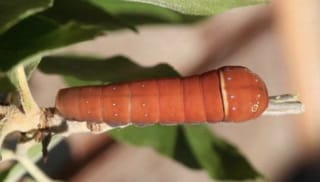 Photo: Whitney Cranshaw | Two-tailed Swallowtail(Papilio multicaudata)Family: Papiliondae (Swallowtails) Size: 3.4 - 5.1 in (9 - 13 cm) Color: yellow Flits: May 01 - Aug 30 Status: native; common Food source: nectar from thistles, milkweeds, lilac and others Host: chokecherry, hoptree Habitat: foothill slopes and canyons, moist valleys, streamsides, woodlands, parks, roadsides, suburbs Our largest permanent resident. Has two tails per hindwing, one very long. Upper wing black bars are thin so butterfly appears mostly yellow. Info Photos |
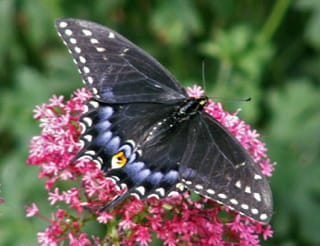 Photo: Yvonne Keller 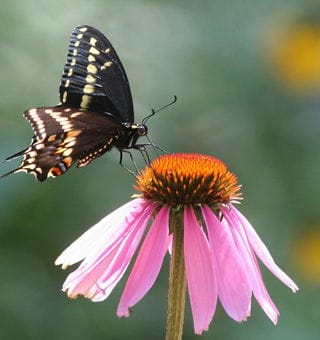 Photo: Selvi Viswanathan 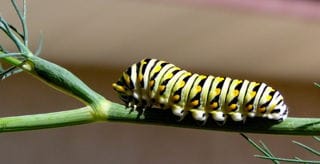 Photo: Earl Hoffman | Black Swallowtail, American Swallowtail, Parsnip Swallowtail(Papilio polyxenes)Family: Papiliondae (Swallowtails) Size: 2.6 - 3.5 in (7 - 9 cm) Color: black Flits: Jun 01 - Aug 15 Status: native; common Food source: nectar from red clover, milkweed, and thistles Host: parsley family Habitat: variety of open areas including fields, suburbs, deserts, and roadsides One of three local black swallowtails. Has rounded yellow dots along the band of upper side of forewings. Info Photos |
 Photo: Brian Lee Clements 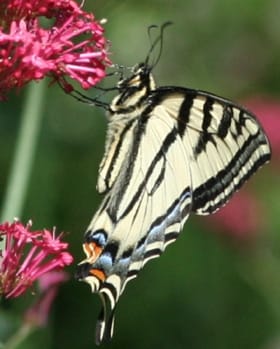 Photo: Selvi Viswanathan  Photo: Todd Stout | Western Tiger Swallowtail(Papilio rutulus)Family: Papiliondae (Swallowtails) Size: 2.8 - 3.9 in (7 - 10 cm) Color: yellow Flits: May 01 - Aug 30 Status: native; common Food source: nectar from many flowers including thistles, abelia, and zinnia Host: willows, aspens Habitat: woodlands near rivers and streams, wooded suburbs, canyons, parks, roadsides, and oases A large butterfly. Has two short tails per wing but the outer is not very long. Upper wing black bars are prominent. Info Photos |
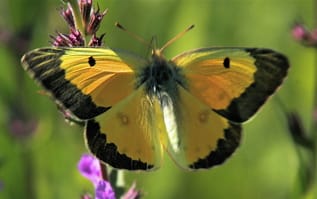 Photo: Dan Mullen 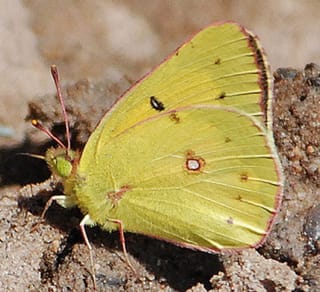 Photo: Jerry Oldenettel | Orange Sulphur(Colias eurytheme)Family: Pieridae (Whites and Sulphurs) Size: 1.6 - 2.4 in (4 - 6 cm) Color: yellow Flits: May 01 - Nov 15 Status: native; common Food source: nectar from many kinds of flowers including dandelion, milkweeds, goldenrods, and asters Host: clovers and other legumes Habitat: wide variety of open sites, fields, meadows, road edges A bright yellow butterfly with black bands around the upper sides of the wings. Rarely holds still. Info Photos |
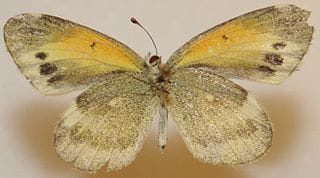 Photo: Megan McCarthy 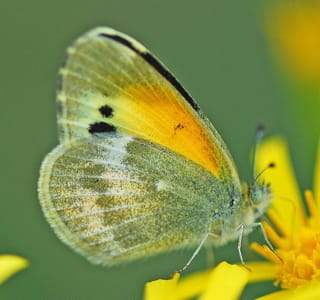 Photo: Jerry Oldenettel 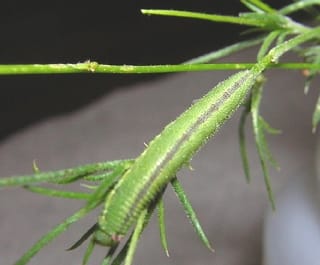 Photo: Todd Stuart | Dainty Sulphur(Nathalis iole)Family: Pieridae (Whites and Sulphurs) Size: 0.8 - 1.1 in (2 - 3 cm) Color: yellow Flits: May 15 - Sep 30 Status: native; common Food source: nectar from asters, wild marigold, rabbitbush, and others Host: sneezeweed, garden marigolds, chickweed Habitat: open, dry places including weedy fields, grasslands, road edges, meadows, and hillsides Flies low. Underside of hindwing is green/gray. Info Photos |
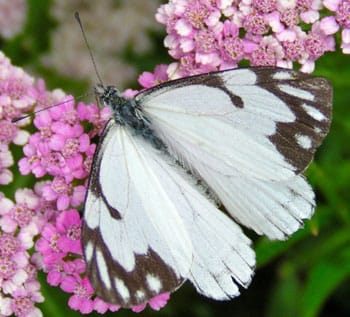 Photo: Earl Hoffman 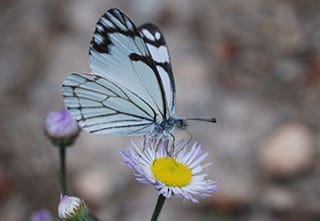 Photo: Sally King  Photo: Jim P. Brock | Pine White(Neophasia menapia)Family: Pieridae (Whites and Sulphurs) Size: 1.8 - 2 in (4 - 5 cm) Color: white Flits: May 13 - Sep 30 Status: native; common Food source: nectar from rabbitbrush and other yellow-flowered composites Host: pines Habitat: coniferous forests Flies high in a manner like it has a broken wing. Info Photos |
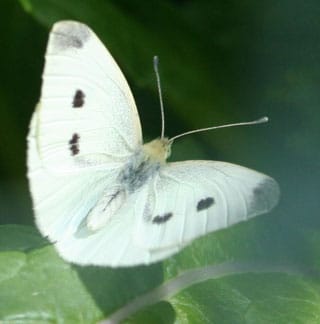 Photo: Selvi Viswanathan 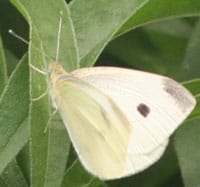 Photo: Selvi Viswanathan 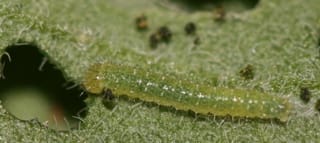 Photo: Todd Stout | Cabbage White, White Cabbage Butterfly(Pieris rapae, Artogeia rapae)Family: Pieridae (Whites and Sulphurs) Size: 1.3 - 1.9 in (3 - 5 cm) Color: white Flits: May 01 - Sep 30 Status: native; common Food source: nectar from a very wide array of plants including mustards, dandelion, red clover, asters, and mints Host: members of the cabbage family Habitat: many types of open space including weedy areas, roadsides, cities, and suburbs A serious agricultural pest. Info Photos |
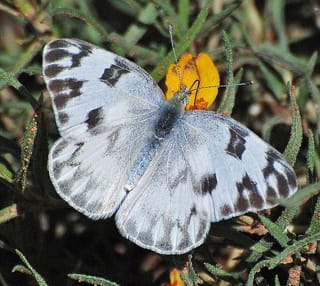 Photo: Jerry Oldenettel 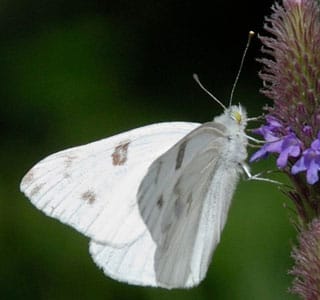 Photo: Marion Stelts 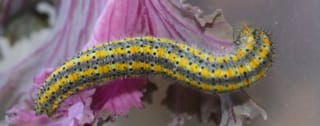 Photo: Todd Stout | Checkered White(Pontia protodice)Family: Pieridae (Whites and Sulphurs) Size: 1.5 - 2.5 in (4 - 6 cm) Color: white Flits: May 01 - Sep 30 Status: native; common Food source: nectar from mustards and composites Host: beeweed, members of the cabbage family Habitat: dry weedy areas, vacant lots, fields, pastures, sandy areas, railroad beds, and roads Seen throughout the area. Our most common white. Info Photos |
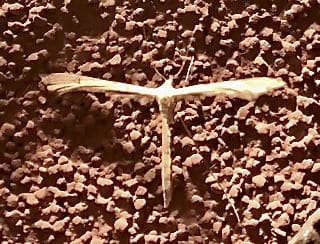 Photo: Chick Keller 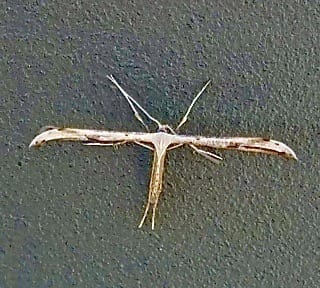 Photo: Siobhan Niklasson 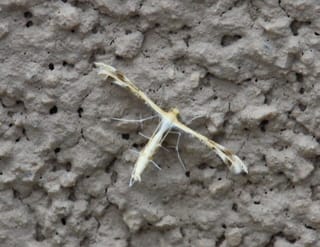 Photo: Joel DuBois | Plume Moth, Pterophorid Moth(numerous species in several genera)Family: Pterophoridae (Plume Moths) Size: 0.5 - 1.6 in (1 - 4 cm) Color: brown Flits: Mar 01 - Nov 30 Status: native; uncommon Food source: nectar and pollen Host: large variety of plants including many from the sunflower family Habitat: on flowers during the day; at light sources during dark Plume Moths tend to have muted colors but be very distinctive. They have thin, long wings which are held at a 90-degree angle from the body, long thin abdomen, and extremely long legs. When resting, the wings are usually held in a tight roll but can be spread in such a way as to show off feathery plumes giving the Pterophoridaefamily its common name. These moths are weak and fluttery in flight. There are over 150 different named species of Plume Moth in the US. Many of these are fairly similar making it very hard to distinguish from one another. Info Photos |
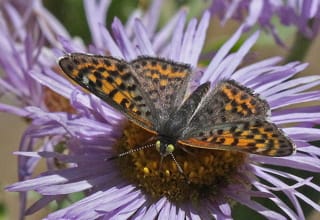 Photo: Jerry Oldenettel 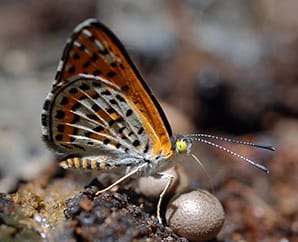 Photo: Sally King | Nais Metalmark(Apodemia nais)Family: Riodinidae (Metalmarks) Size: 1.1 - 1.5 in (3 - 4 cm) Color: orange Flits: Jun 01 - Jul 31 Status: native; common Food source: flower nectar Host: buckbrush Habitat: open pine forest, streamsides Upperside is checkered with dark brown and orange-brown; underside gray with scattered black spots Info Photos |
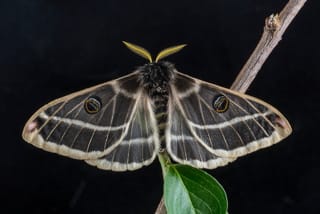 Photo: © Jim & Lynne Weber 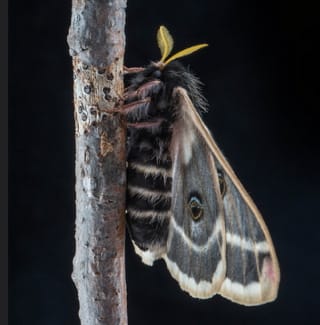 Photo: © Jim & Lynne Weber 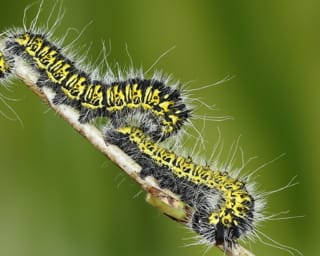 Photo: © Roger Wasley | Rocky Mountain Agapema(Agapema homogena)Family: Saturniidae (Giant Silkworm Moths) Size: 2.9 - 3.9 in (7 - 10 cm) Color: gray Flits: May 15 - Jul 30 Status: native; uncommon Food source: adults do not feed Host: buckthorns, willows and currants Habitat: wooded areas above 4,400 ft (1,300 m) This Silkmoth is gray to black with white markings and eyespots. Adults are nocturnal. Eggs are deposited in clusters and the larvae feed in groups upon hatching. Once the caterpillars reach their last stage, they form cocoons in crevices around rocks and tree trunks. Info Photos |
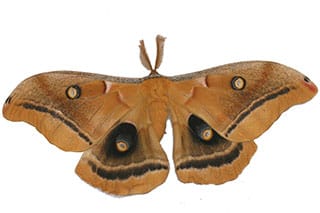 Photo: Garth Tietjen 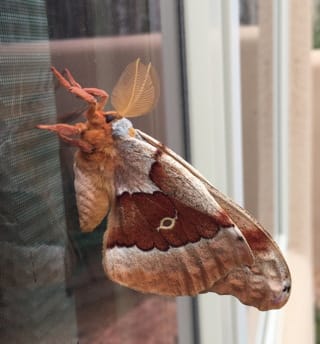 Photo: Pat Bacha 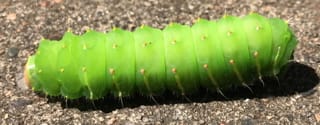 Photo: Una Smith | Polyphemus Moth(Antheraea polyphemus)Family: Saturniidae (Giant Silkworm Moths) Size: 3.5 - 5.5 in (9 - 14 cm) Color: black, brown Flits: May 15 - Jul 31 Status: native; uncommon Food source: adults do not eat Host: variety of trees including oak, willow and maple Habitat: deciduous forests and parks This is one of the largest moths in the US. It was named for the Greek cyclops, Polyphemus, due to the prominent eye spot on each wing. The caterpillars are solitary and if threatened they can rear up the front part of their body as well as make a clicking noise. Info Photos |
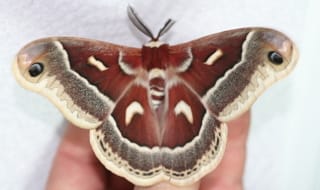 Photo: Garth Tietjen 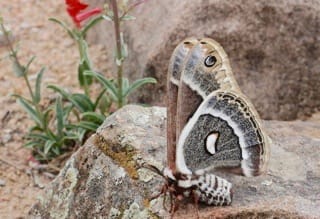 Photo: Beth Cortright 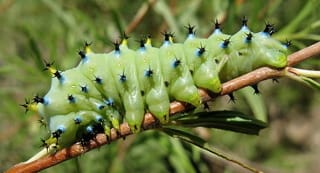 Photo: Don Ehlen | Glover's Silkmoth, Columbia Silkmoth(Hyalophora columbia, Hyalophora gloveri)Family: Saturniidae (Giant Silkworm Moths) Size: 3.1 - 3.9 in (8 - 10 cm) Color: gray, orange Flits: Apr 01 - Jul 15 Status: native; uncommon Food source: adults do not feed Host: a variety of trees and shrubs, with the most common being cherry, rose, willow and olive Habitat: areas with wet soil Once considered a separate species now treated as a subspecies of the Columbia Silkmoth. Adults only survive for a short period of time during which time they are actively involved in mating, often in the early morning hours. Young caterpillars are susceptible to being parasitized by several different species of wasps and flies. Info Photos |
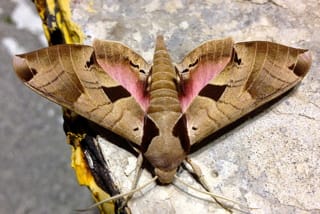 Photo: Angelique Harshman 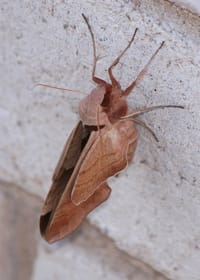 Photo: J. N. Stuart 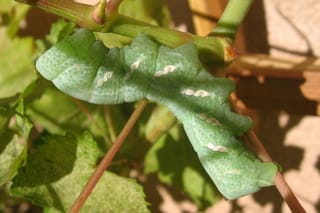 Photo: Johnida Dockens | Achemon Sphinx(Eumorpha achemon)Family: Sphingidae (Sphinx Moths and Hawkmoths) Size: 3.4 - 3.8 in (9 - 10 cm) Color: brown, pink Flits: Jun 01 - Jul 31 Status: native; common Food source: nectar from flowers such as Jimpson weed and four o’clocks Host: various vines and ivies Habitat: wooded and scrubby habitats and inhabited areas The adults usually only fly at night flitting between plants with fragrant flowers and long long flora tubes. They use their very long tongues to reach the nectar in the bottom of these flowers. There are three different colored forms of larvae: light green, reddish orange, and tan to brown. The larvae can often be seen in vineyards feeding on the vine leaves. Info Photos |
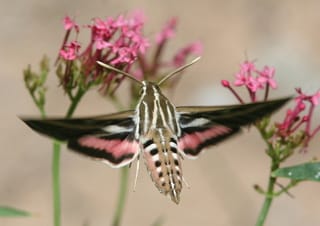 Photo: Selvi Viswanathan 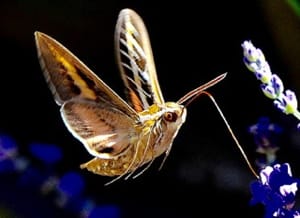 Photo: Larry Lamsa 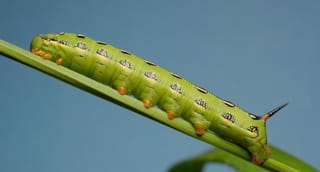 Photo: Joseph Berger | White-lined Sphinx, Hummingbird Moth(Hyles lineata)Family: Sphingidae (Sphinx Moths and Hawkmoths) Size: 2 - 3 in (5 - 8 cm) Color: black, brown, pink, white Flits: Jun 01 - Sep 30 Status: native; common Food source: nectar from a variety of flowers including columbines, larkspurs, clovers, thistles and Jimson weed Host: large range of trees and shrubs Habitat: areas with flowers in full bloom The White-lined Sphinx, as well as several other species, go by the nickname of “Hummingbird Moth” due to their rapid wing movement that resembles a hummingbird in flight. The adults primarily feed from dusk to dawn but occasionally can be seen during daylight hours. Although several generations of this moth may occur in a year, typically they are most obvious during July and August. Periodic population buildups occur stimulating emigrations to colonize new areas. Larvae can vary in color from yellow and black to lime green and black. When larvae are ready to pupate, they burrow into the soil and stay there for about three weeks before emerging as adults. Info Photos |
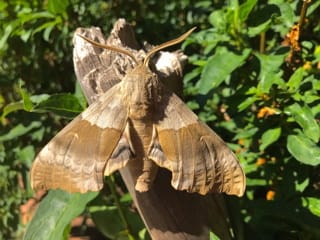 Photo: Chick Keller 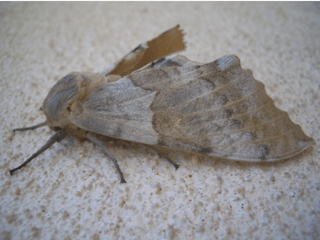 Photo: H. Trudell 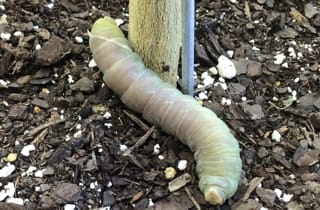 Photo: jnewt83 | Western Popular Sphinx, Big Popular Sphinx(Pachysphinx occidentalis)Family: Sphingidae (Sphinx Moths and Hawkmoths) Size: 5.2 - 5.8 in (13 - 15 cm) Color: brown, yellow Flits: May 15 - Sep 01 Status: native; common Food source: adults do not feed Host: cottonwood, poplar, and willow Habitat: suburban and riparian areas There are two colors forms of the Western Popular Sphinx, a pale form with yellow brown forewings and a dark form that is more gray. There is a touch of crimson on the upper-side of the hind wings along with two distinctive dark lines. Females lay their eggs on the leaves of Populus and Salix tree species. The fully-grown caterpillars spend the winter in the ground in a shallow hole as pupa. Info Photos |
